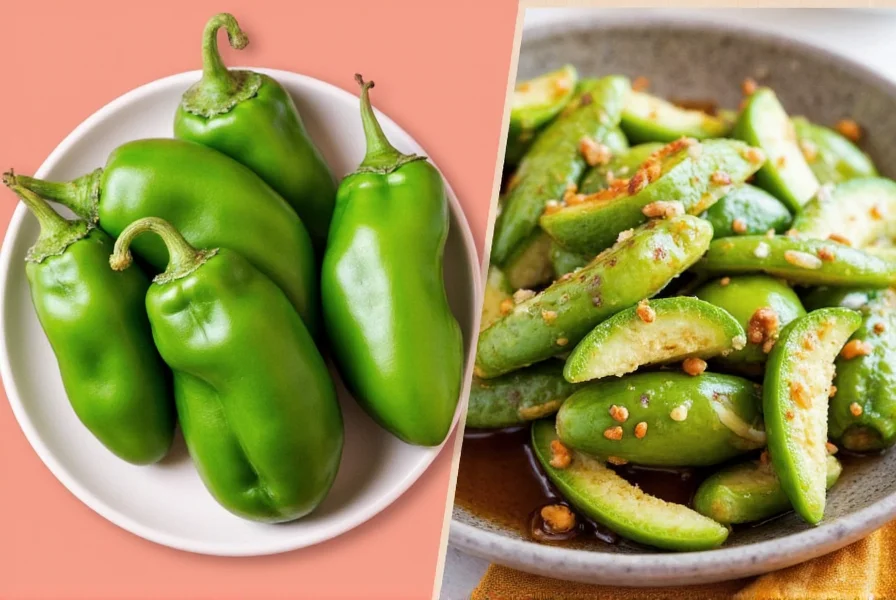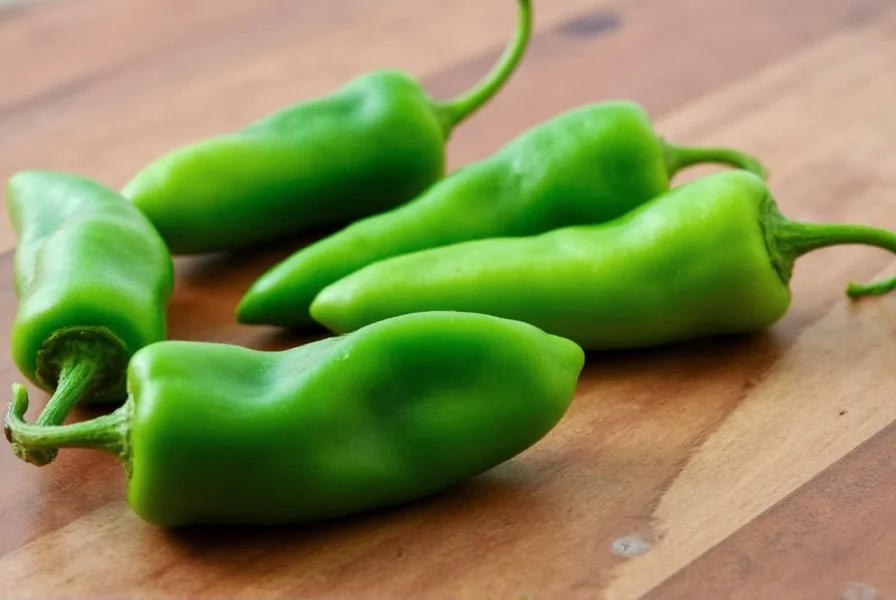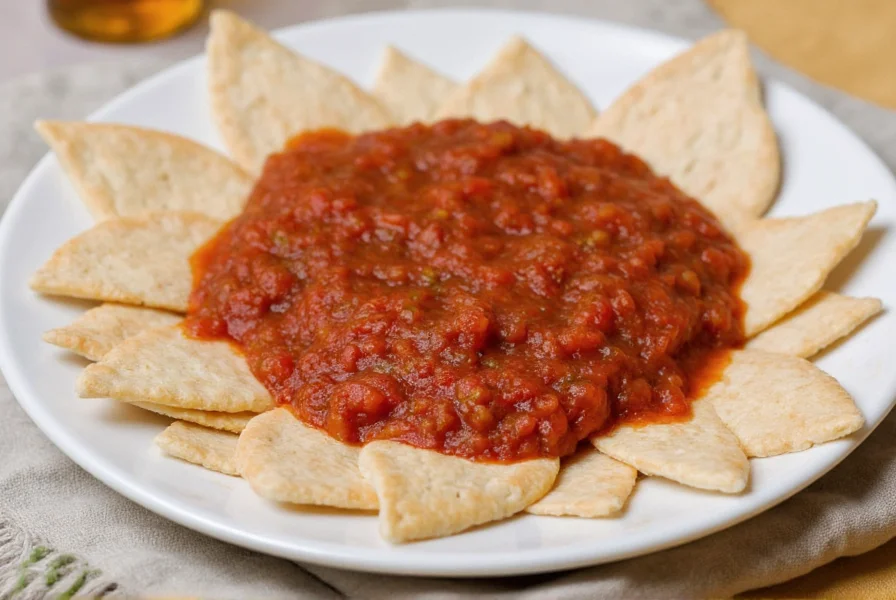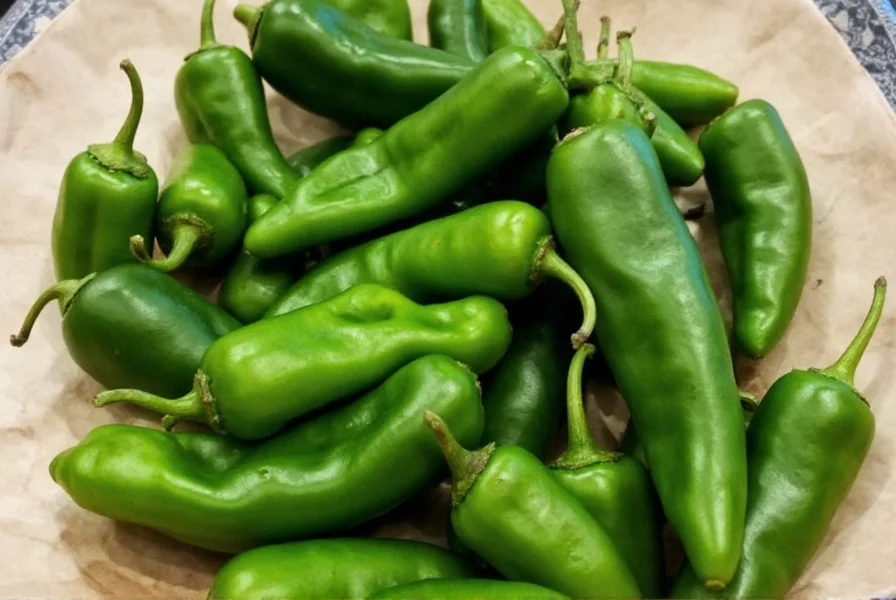Curious about poblano heat level? You're not alone. Many people wonder: are poblanos spicy or mild? This guide reveals exactly how hot poblanos are, how they compare to other peppers, and practical tips to control their heat while maximizing flavor in your cooking. Discover why poblanos are the perfect choice for those who want mild spice without overwhelming heat.

| Pepper Type | Scoville Heat Units (SHU) |
|---|---|
| Green Bell Pepper | 0 SHU |
| Poblano Pepper | 1,000 – 2,000 SHU |
| Jalapeño Pepper | 2,500 – 8,000 SHU |
| Hatch Green Chile | 1,000 – 8,000 SHU |
| Serrano Pepper | 10,000 – 23,000 SHU |
| Chile Type | Heat Level (SHU) | Texture | Flavor Profile | Best Use |
|---|---|---|---|---|
| Poblano | 1,000 – 2,000 | Firm, thick flesh | Earthy, grassy | Stuffing, roasting, sauces |
| Jalapeño | 2,500 – 8,000 | Crisp, smooth skin | Grassy, tangy | Salsas, pickling, pizza |
| Ancho | 1,000 – 2,000 | Dry, leathery | Sweet, raisin-like | Mole, soups, stews |
| Guajillo | 2,500 – 5,000 | Thin, papery | Tangy, berry-like | Sauces, marinades |
| Product | Description | Advantages | Use Cases | Occasions |
|---|---|---|---|---|
| Mexi-Best Organic Poblanos | Organically grown, hand-harvested, sustainably farmed | Consistent size, minimal waste, clean flavor | Stuffing, roasting, grilling | Weeknight dinners, entertaining |
| Naturo Packaged Roasted Poblanos | Peeled and diced, vacuum-sealed in brine | Convenient, no prep needed | Blending into sauces, soups, casseroles | Quick meals, meal prep |
| El Paso Dried Whole Ancho Chiles | Authentic dried anchos from Mexico | Rich flavor, easy to rehydrate | Making homemade mole, stews, or chili | Special occasion cooking |
How hot are poblano peppers on the Scoville scale?
Poblano peppers typically range from 1,000 to 2,000 Scoville Heat Units (SHU). This makes them mildly spicy - noticeably more than bell peppers (which are 0 SHU) but significantly milder than jalapeños (which range from 2,500-8,000 SHU).
Are poblanos hotter than jalapeños?
No, poblanos are generally milder than jalapeños. The hottest poblano (2,000 SHU) is still less spicy than the mildest jalapeño (2,500 SHU). On average, jalapeños are about twice as hot as poblanos.
Can you eat raw poblano peppers?
Yes, you can eat raw poblano peppers. They have a slightly bitter, earthy flavor when raw. Many people enjoy them in salsas or sliced on sandwiches. The heat level when raw is mild for most people, though sensitive palates might notice some warmth.
Why do some poblanos taste much spicier than others?
Poblano heat can vary significantly due to several factors: maturity (redder = spicier), growing conditions (stressful conditions increase capsaicin), and individual pepper variation. It's not uncommon to find one noticeably spicier poblano in a batch of otherwise mild ones.
How can I reduce the heat of poblano peppers?
To reduce heat: 1) Remove all seeds and white membranes (where most capsaicin resides) 2) Roast the peppers (this mellows the heat) 3) Pair with dairy products like cheese or cream 4) Cook with acidic ingredients like lime juice or tomatoes 5) Choose darker green (less ripe) poblanos which tend to be milder.
What's the difference between fresh poblanos and dried ancho chiles?
They're actually the same pepper at different stages! Fresh green peppers are poblanos; when allowed to ripen to red and then dried, they become ancho chiles. Anchos have a deeper, sweeter, raisin-like flavor and similar heat level (1,000-2,000 SHU), but the texture and culinary uses differ significantly.
Can I substitute poblano peppers for bell peppers in recipes?
You can substitute poblanos for bell peppers if you want to add mild heat and deeper flavor. Keep in mind that poblanos have some spiciness (though mild) and a different texture (thicker walls). For a direct substitute where no heat is desired, you'd need to remove all seeds and membranes from the poblanos.
What Is a Poblano Pepper?
The poblano pepper (Capsicum annuum) is a type of chili pepper originating from Mexico — specifically the state of Puebla, which is where it gets its name. When fresh, it's large, heart-shaped, and dark green. Once dried, it becomes ancho chile — which has a different flavor profile and usage.
Known for its rich flavor and mild heat, the poblano pepper is a staple in traditional Mexican dishes like chiles rellenos, mole poblano, and various salsas. But let's get one thing straight: while mild, it's definitely not without kick. Let's dig into just how much heat you can expect.

Understanding the Poblano Heat Level
To truly grasp the poblano heat level, we need to talk about the Scoville Scale — the measurement system that tells us how hot a pepper really is.
So where does that leave the poblano? Pretty mild on the grand scale of spicy things, but certainly not bland. For context, the average jalapeño is about twice as hot as the upper end of the poblano range.
But here's the kicker: the poblano heat level isn't fixed. It can vary depending on several factors:
- Maturity: Riper, redder poblanos tend to be spicier than their greener counterparts.
- Growing Conditions: Soil, climate, and even the time of year can influence capsaicin levels.
- Seed Removal: Like most peppers, removing the seeds and white membranes will significantly reduce the heat.

Poblano vs. Other Chiles: A Side-by-Side Comparison
Let's take a look at how the poblano stacks up against some of its more famous relatives in the chili family. Understanding these differences helps you choose the right pepper for the job — especially when heat level plays a role.
Jalapeño vs. Poblano
While both are used in Tex-Mex and Mexican cuisine, jalapeños are typically hotter and crunchier. Poblanos offer a deeper, earthier flavor with a milder punch — making them better suited for stuffing or blending into sauces.
Guajillo vs. Poblano
Dried guajillos (from ripe red mirasol peppers) are often used in mole sauces and come in around 2,500–5,000 SHU. They're drier and fruitier than poblanos, which are meatier and creamier when roasted.
Ancho vs. Poblano
This one's interesting: ancho is just the dried form of a ripe red poblano. The drying process intensifies the sweetness and gives it a raisin-like flavor, though it's not necessarily hotter.
Cooking with Poblanos: Tips & Tricks
Now that you know how hot a poblano pepper is, let's talk about how to make the most of it in the kitchen. Whether you're roasting, peeling, or stuffing, here are some tried-and-true methods to maximize flavor while keeping heat in check.
1. Roast Them Before Using
Rub a bit of oil on whole poblanos and roast them directly over a gas flame or under a broiler until blistered and blackened. Place them in a paper bag for 10 minutes to steam, then peel off the skin. This enhances the smoky depth of the pepper and softens the heat.
2. Remove Seeds for Milder Flavor
If you're concerned about the poblano heat level, always remove the seeds and white membranes before cooking. That's where most of the capsaicin lives.
3. Try Them Stuffed
Chiles rellenos are a classic example — stuffed with cheese, dipped in egg batter, and fried. Because of their thick walls, poblanos hold up beautifully to stuffing and baking.
4. Add to Salsas and Sauces
Blend roasted poblanos with garlic, tomatoes, and lime for a creamy, smoky salsa verde. It's perfect for drizzling over tacos or enchiladas.
5. Freeze for Later Use
You can freeze whole roasted poblanos in airtight bags. When thawed, the skins slip off easily, and you'll still get that amazing roasted flavor months later.

Buying Guide: How to Choose the Best Poblanos
If you're ready to stock up on poblanos for your next culinary adventure, here's how to choose the best ones at the market or grocery store.
Look for Firmness
Fresh poblanos should feel firm to the touch. Avoid any that are wrinkled, mushy, or overly soft — those are past their prime.
Check the Color
Most poblanos sold in stores are green, but if you see redder ones, they'll be riper and slightly spicier. If you prefer mild flavor, stick with darker green specimens.
Inspect the Skin
Smooth skin is ideal. Blemishes, cuts, or bruises can lead to quicker spoilage.
Storage Tips
- Refrigerator: Store unwashed in a plastic bag for up to two weeks.
- Freezer: Roast and freeze for long-term storage (up to six months).
- Drying: String them up and hang in a dry place for use in soups and stews.
Conclusion: Embrace the Mild Fire of Poblanos
So, what's the final verdict on the poblano heat level? Simply put, it's mildly spicy — somewhere between a bell pepper and a jalapeño — making it incredibly versatile in the kitchen. Whether you're a seasoned home cook or just starting out, the poblano offers the perfect balance of flavor and warmth without overwhelming your palate.
Don't be afraid to experiment! Roast them, stuff them, blend them into sauces — the possibilities are endless. And now that you know how to manage the heat, you can confidently incorporate this beloved Mexican staple into your cooking rotation.
Got a favorite way to use poblanos? Share your go-to recipe below — let's keep the spice-loving community rolling!










 浙公网安备
33010002000092号
浙公网安备
33010002000092号 浙B2-20120091-4
浙B2-20120091-4